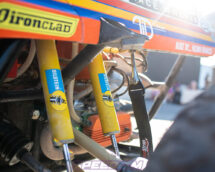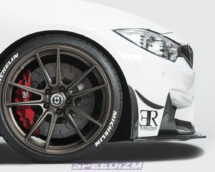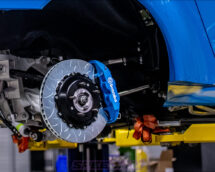A Practical Approach to Stance
Though they might disagree on the details, most performance car enthusiasts put a lowered ride height at the top of the list when it comes to customizing. From the factory, even most sports cars have a suspension that is a compromise between grip, ride comfort, and manufacturing costs. Corvettes and Porsches are expected to be able to handle rust-belt potholed streets and uneven freeway expansion joints without reducing the occupants’ internal organs to mush, let alone cars that are less narrowly-focused on handling.

The practical requirements of selling cars to a large audience often lead to unsatisfying compromises like excessive fender gap and tall ride height. Fortunately, there’s an enormous aftermarket that caters specifically to customizing this aspect of suspension design. Unfortunately, it also makes it possible to completely ruin a car’s handling and drivability, either accidentally or on purpose.

From a practical standpoint, lowering a car’s center of gravity does a number of good things. Most importantly, it reduces the leverage applied to the chassis by cornering forces. Imagine a brick sitting on its small end versus one laid flat – it’s intuitively obvious that it’s much easier to tip over the one standing upright than the one with a lower center of gravity, even though they are the same mass. A low CG helps the suspension keep all four tires in positive contact with the road and contributing to the cornering forces.

Another significant advantage of reduced ride height is helping to limit the amount of airflow that passes beneath the chassis. This reduces drag and aerodynamic lift, and many high-end cars with electronically-controlled suspensions are programmed to automatically “squat” as road speed increases to take advantage of this fact while still providing full ride height at lower speeds. Track cars that are optimized for smooth pavement with very little suspension travel typically have very low ride height, and that look has become fashionable for street cars as well, despite the serious drawbacks for daily driving.

From “Why” to “How”
Regardless of the reason for lowering a car, there are several ways to do it. These range from ideal but expensive and complicated solutions like moving the attachment points to the chassis higher up relative to their stock positions, to terrible ones, like cutting coils off of stock springs. For the sake of emphasis, let’s start on the “cheap but awful” end of the scale and talk about why modifying stock springs is such a bad idea.
For the sake of emphasis, let’s start on the “cheap but awful” end of the scale and talk about why modifying stock springs is such a bad idea.

First, since coil springs are, with rare exceptions, the type of spring we’ll be dealing with in modern automotive suspensions, we need to understand how they work. It’s not intuitively obvious, but a coil spring is actually a torsion bar wound into a cylinder. If you were to take a coil spring and put marks across the ends with it uncompressed, then put weight on it until you reached coil bind (more on that in a minute), you’d notice that the marks rotated relative to one another as pressure was applied and the spring twisted.

In practical terms, this means that if all other things like the steel they’re made from and the diameter of the spring wire itself are the same, a spring with fewer coils will be stiffer than one with more coils. While cutting a factory spring makes the spring itself shorter, lowering ride height (and reducing suspension travel in compression, too), it also makes the spring stiffer.
Rate My Springs
Springs are defined by their ‘rate’ – x amount of weight will compress that spring by a specific distance, and this is typically listed in pounds required to compress the spring one inch. A 600 pound/inch spring is going to be far stiffer than a 200 pound/inch spring. You’ll notice that on front wheel drive cars in particular, the front springs will have a much higher spring rate than the rear, because they carry more of the car’s weight. Most coil springs are also ‘progressive rate,’ with one section with a lot of coils and another with fewer, more widely-spaced ones. This allows the spring to spend most of its time at a lower rate for better ride quality and handling, firming up once enough force is applied to make the low-rate section’s coils touch each other (known as coil bind) and start acting like a solid spacer.

Looping back around to the original point, cutting factory springs results in a far higher (and unknown, unless you have a press and a scale to test it) spring rate; although this may provide the desired results in terms of lowering, it’s very likely that you will be unhappy with what it does to ride quality and handling. Even if we can’t convince you not to try it, at the very least don’t do it with a torch, because putting all that heat into the spring will absolutely murder the heat treatment of the steel as well, throwing another unknown variable into the equation.

A better solution is a properly engineered lowering spring kit designed for your chassis and manufactured by a reputable company. You may be tempted by the low price of eBay or (shudder…) Wish parts, but considering how affordable high quality spring kits are that actually have traceable manufacturing and aren’t made from recycled shipping containers are, is it worth rolling the dice? This is one place where you absolutely can’t cut corners – a broken spring will ruin your day at best, and at worst could lead to a fatal loss of control.

A good lowering spring kit will clearly state the spring rates front and rear, the amount of drop to expect, and whether other components like bump stops need to be modified or replaced. The manufacturer will also be able to tell you if it’s likely that you will need additional parts to correct the suspension’s camber for proper alignment once their springs are installed.
The Camber Question
For the uninitiated, camber is the measurement of how level the tire is side-to-side compared to the pavement. In Perfect Physics World, zero camber is ideal for handling because it allows all the cornering forces to be applied evenly across the entire width of the tread’s contact patch. In the real world, some negative camber at rest (top of the tire tilted in towards the car’s centerline) is desirable for optimum handling because it takes into account the flexibility of the tire itself.

Many car suspensions are designed to increase negative camber as the spring is compressed; this has the advantage of improving grip as weight is transferred to the outside wheels in a turn, without requiring excessive camber settings at normal ride height. It also has the secondary benefit of allowing more room for wider tires and wheels by moving the top of the tire inward, away from the fender, as the suspension is compressed.

This also means that lowering springs that put the suspension in the upper part of its travel ‘at rest’ will increase the base camber. Some people find the look of negative camber appealing, despite the fact that on the street, it absolutely destroys tires by concentrating straight-line wear on the inner third of the tread. For those more concerned with performance than appearance, the amount of adjustment available in the stock suspension mounts may not be enough to compensate for the additional negative camber, but for many applications ‘camber kits’ are available to bring things back to the desired spec.
Going Static

Next on the list in terms of cost, sophistication, and adjustability are coilover conversions, which get their name from the fact that they consist of a concentric spring and damper, putting the ‘coil over’ the shock. For strut-type suspensions, these can be as simple as a threaded sleeve with a spring stop and a standard-diameter coil spring designed to slide over the strut body and replace the factory spring. Many factory suspension designs separate the spring and damper, so a coilover conversion for those basically eliminates the individual shock and spring units with a single integrated component mounted where the stock damper used to be.
Once again, this is a situation where you get what you pay for. Reputable manufacturers are the way to go, saving you a lot of grief and frustration down the road. Almost every coilover setup you’ll find will be adjustable for ride height via a threaded collar that moves up and down the sleeve and is secured in position with either a second collar that acts as a jam nut, or some kind of setscrew arrangement. Springs can be straight-rate or progressive, and on components designed for racing use, they’ll often have a second short and very low-rate “helper” spring that acts like a spacer even when the car is level, but expands and secures the main spring in place when the suspension is at full droop.

More-sophisticated coilover systems will replace the non-adjustable dampers with single- or double-adjustable units to allow fine-tuning of the suspension response. A single-adjustable damper will either adjust both compression and rebound together, or just compression with a fixed rebound rate, while a double-adjustable one will have separate controls for compression and rebound. At the risk of repeating ourselves, the advantage of sourcing these kinds of suspension components from a reputable manufacturer is that they’ll almost always have advice for the initial settings that will work for most people and get the rest in the ballpark – remember that ‘more adjustment’ also means ‘most of the settings are wrong.’

Airing it Out
Finally, there are air suspensions. These are similar to coilovers in that they replace the factory springs and dampers, but instead of using coiled steel as a spring, they utilize air pressure. The advantage of an air suspension is that ride height is adjustable simply by adding or releasing pressure from the individual air springs, but this kind of suspension got a bad reputation years ago for a number of different reasons.
…as long as it was possible to ‘lay frame’ and get as much drop as possible

Because properly engineered, application-specific kits weren’t available, owners often hacked together generic components, not caring too much about how the car rode or handled at a reasonable ride height as long as it was possible to “lay frame” and get as much drop as possible.

Thanks to an increasing number of OEM luxury vehicles that incorporate air springs as part of an adjustable suspension, today’s sophisticated air suspensions use air springs that maintain a more or less constant spring rate, regardless of how much pressure they’re set at or what the ride height is. This is a huge difference from the jury-rigged setups of yesterday that went from mushy down low to molar-loosening at max pressure. They’ll also typically be paired with adjustable dampers as well, making them suitable not just for lowering a vehicle, but also for performance applications. Though they aren’t cheap, they offer an enormous range of ride height and damping adjustments, and eliminate the possibility of your car appearing in a viral video with the wheels spinning helplessly, hung up on a curb cut like a landing craft beached on D-Day.

While we haven’t had a chance to go into too much detail in the space we have here, you should come away with a better understanding of your options, whether you want to lower your car for looks or performance. Whatever you choose, please remember that your car’s suspension is not a place to try to ‘make something work’; failure of components or radically altering the factory geometry is dangerous not just to you, but everyone you encounter on the road.









